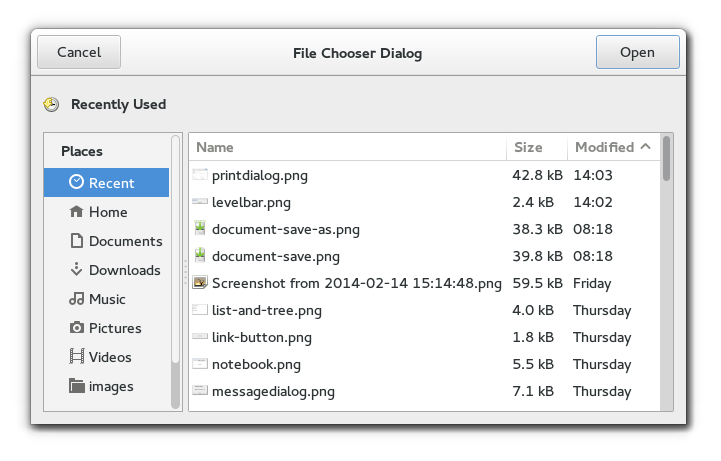| Top |
GtkFileChooserDialogGtkFileChooserDialog — A file chooser dialog, suitable for “File/Open” or “File/Save” commands |
 |
Object Hierarchy
GObject ╰── GInitiallyUnowned ╰── GtkWidget ╰── GtkContainer ╰── GtkBin ╰── GtkWindow ╰── GtkDialog ╰── GtkFileChooserDialog
Implemented Interfaces
GtkFileChooserDialog implements AtkImplementorIface, GtkBuildable and GtkFileChooser.
Description
GtkFileChooserDialog is a dialog box suitable for use with “File/Open” or “File/Save as” commands. This widget works by putting a GtkFileChooserWidget inside a GtkDialog. It exposes the GtkFileChooser interface, so you can use all of the GtkFileChooser functions on the file chooser dialog as well as those for GtkDialog.
Note that GtkFileChooserDialog does not have any methods of its own. Instead, you should use the functions that work on a GtkFileChooser.
If you want to integrate well with the platform you should use the GtkFileChooserNative API, which will use a platform-specific dialog if available and fall back to GtkFileChooserDialog otherwise.
Typical usage
In the simplest of cases, you can the following code to use GtkFileChooserDialog to select a file for opening:
1 2 3 4 5 6 7 8 9 10 11 12 13 14 15 16 17 18 19 20 21 22 23 24 |
GtkWidget *dialog; GtkFileChooserAction action = GTK_FILE_CHOOSER_ACTION_OPEN; gint res; dialog = gtk_file_chooser_dialog_new ("Open File", parent_window, action, _("_Cancel"), GTK_RESPONSE_CANCEL, _("_Open"), GTK_RESPONSE_ACCEPT, NULL); res = gtk_dialog_run (GTK_DIALOG (dialog)); if (res == GTK_RESPONSE_ACCEPT) { char *filename; GtkFileChooser *chooser = GTK_FILE_CHOOSER (dialog); filename = gtk_file_chooser_get_filename (chooser); open_file (filename); g_free (filename); } gtk_widget_destroy (dialog); |
To use a dialog for saving, you can use this:
1 2 3 4 5 6 7 8 9 10 11 12 13 14 15 16 17 18 19 20 21 22 23 24 25 26 27 28 29 30 31 32 33 34 35 |
GtkWidget *dialog; GtkFileChooser *chooser; GtkFileChooserAction action = GTK_FILE_CHOOSER_ACTION_SAVE; gint res; dialog = gtk_file_chooser_dialog_new ("Save File", parent_window, action, _("_Cancel"), GTK_RESPONSE_CANCEL, _("_Save"), GTK_RESPONSE_ACCEPT, NULL); chooser = GTK_FILE_CHOOSER (dialog); gtk_file_chooser_set_do_overwrite_confirmation (chooser, TRUE); if (user_edited_a_new_document) gtk_file_chooser_set_current_name (chooser, _("Untitled document")); else gtk_file_chooser_set_filename (chooser, existing_filename); res = gtk_dialog_run (GTK_DIALOG (dialog)); if (res == GTK_RESPONSE_ACCEPT) { char *filename; filename = gtk_file_chooser_get_filename (chooser); save_to_file (filename); g_free (filename); } gtk_widget_destroy (dialog); |
Setting up a file chooser dialog
There are various cases in which you may need to use a GtkFileChooserDialog:
To select a file for opening. Use GTK_FILE_CHOOSER_ACTION_OPEN.
To save a file for the first time. Use GTK_FILE_CHOOSER_ACTION_SAVE, and suggest a name such as “Untitled” with
gtk_file_chooser_set_current_name().To save a file under a different name. Use GTK_FILE_CHOOSER_ACTION_SAVE, and set the existing filename with
gtk_file_chooser_set_filename().To choose a folder instead of a file. Use GTK_FILE_CHOOSER_ACTION_SELECT_FOLDER.
Note that old versions of the file chooser’s documentation suggested
using gtk_file_chooser_set_current_folder() in various
situations, with the intention of letting the application
suggest a reasonable default folder. This is no longer
considered to be a good policy, as now the file chooser is
able to make good suggestions on its own. In general, you
should only cause the file chooser to show a specific folder
when it is appropriate to use gtk_file_chooser_set_filename(),
i.e. when you are doing a Save As command and you already
have a file saved somewhere.
Response Codes
GtkFileChooserDialog inherits from GtkDialog, so buttons that
go in its action area have response codes such as
GTK_RESPONSE_ACCEPT and GTK_RESPONSE_CANCEL. For example, you
could call gtk_file_chooser_dialog_new() as follows:
1 2 3 4 5 6 7 8 9 10 11 |
GtkWidget *dialog; GtkFileChooserAction action = GTK_FILE_CHOOSER_ACTION_OPEN; dialog = gtk_file_chooser_dialog_new ("Open File", parent_window, action, _("_Cancel"), GTK_RESPONSE_CANCEL, _("_Open"), GTK_RESPONSE_ACCEPT, NULL); |
This will create buttons for “Cancel” and “Open” that use stock response identifiers from GtkResponseType. For most dialog boxes you can use your own custom response codes rather than the ones in GtkResponseType, but GtkFileChooserDialog assumes that its “accept”-type action, e.g. an “Open” or “Save” button, will have one of the following response codes:
This is because GtkFileChooserDialog must intercept responses and switch to folders if appropriate, rather than letting the dialog terminate — the implementation uses these known response codes to know which responses can be blocked if appropriate.
To summarize, make sure you use a stock response code when you use GtkFileChooserDialog to ensure proper operation.
Functions
gtk_file_chooser_dialog_new ()
GtkWidget * gtk_file_chooser_dialog_new (const gchar *title,GtkWindow *parent,GtkFileChooserAction action,const gchar *first_button_text,...);
Creates a new GtkFileChooserDialog. This function is analogous to
gtk_dialog_new_with_buttons().
Parameters
title |
Title of the dialog, or |
[allow-none] |
parent |
Transient parent of the dialog, or |
[allow-none] |
action |
Open or save mode for the dialog |
|
first_button_text |
stock ID or text to go in the first button, or |
[allow-none] |
... |
response ID for the first button, then additional (button, id) pairs, ending with |
Since: 2.4
